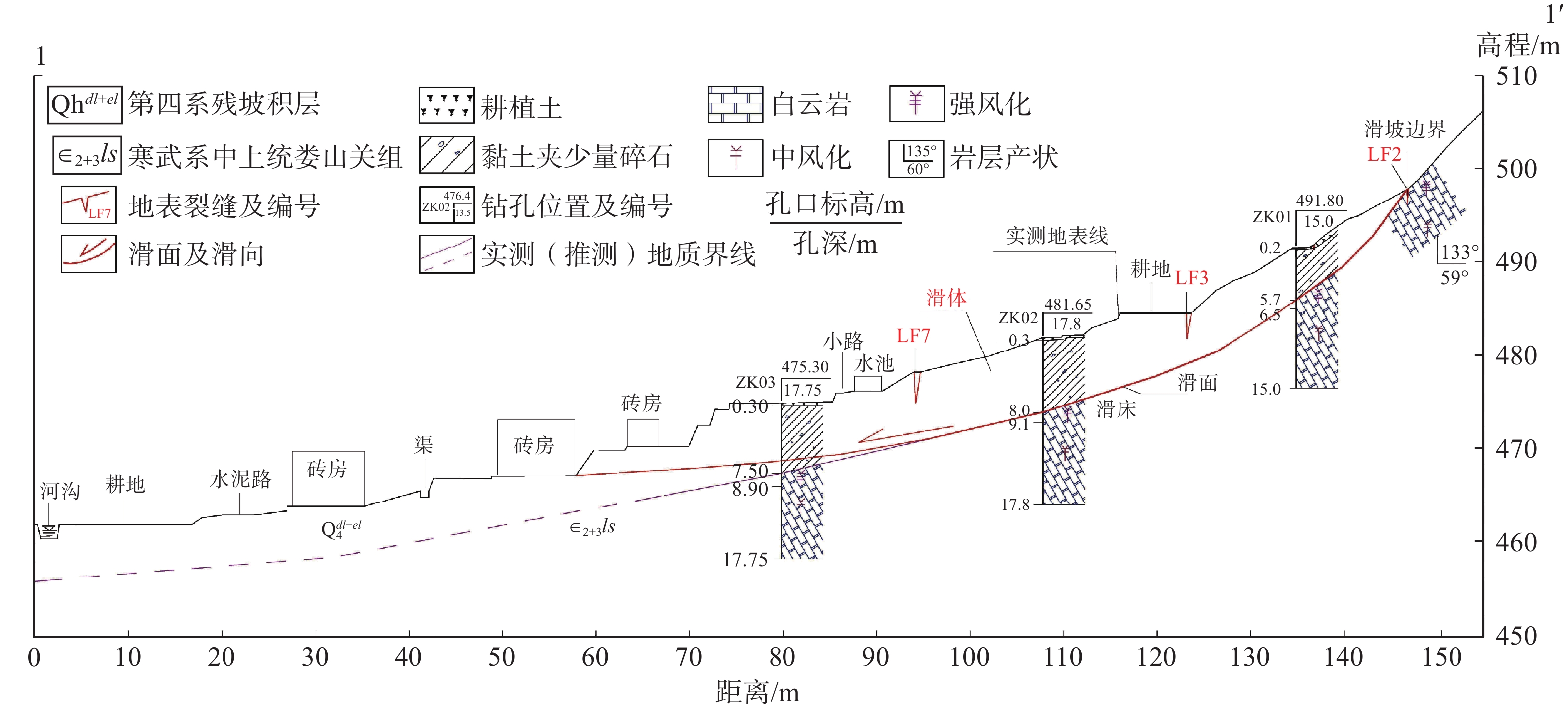Analysis of the formation mechanism of landslide in Changchong group, Songtao, Guizhou
-
摘要: 贵州省属于典型的岩溶山区,第四系覆盖层空间不均匀,具体表现在坡体前缘到中部浅表层为黏性土,后缘为碎石土,随着基覆界面的起伏在垂直方向上厚度差异大。近年来因气候变化异常,极端降雨、暴雨的天数增多,导致强降雨过后浅表层突发性的土质滑坡具有较强的群发现象。论文以贵州省松桃县大路镇和平社区长冲组滑坡为研究对象,通过实地调查、工程地质钻探、岩土试验以及FLAC3D软件模拟等手段,探究降雨前后该滑坡外形特征、岩土结构特征和变形破坏历程,以此来解析该类滑坡的变形破坏过程及发生机理。结果表明:(1)该滑坡为推移式滑坡,其特殊的地形地貌与地层岩性为滑坡发生提供内在因素;(2)降雨是滑坡的主要诱发因素,滑坡发生过程可总结为后缘饱和推压阶段-暂态饱和区扩散变形演进阶段-前缘破坏临空阶段-整体破坏阶段;(3)该滑坡发生的机理主要是在降水因素诱发渗透力变化与坡体重度变化共同作用下导致滑坡体失稳变形。该项探索能为我们更清楚的认识降雨型滑坡早期识别因子以及能够更好更快进行管控和治理提供一定的理论基础。Abstract: Guizhou Province is a mountainous region with typical karst topography where the quaternary overburden layer is unevenly distributed, with clayey soil on the shallow surface layer from the front edge to the middle of the slope body and gravelly soil at the rear edge. This geological characteristic, combined with the increase of extreme rainfall and heavy rainfall due to abnormal climate change in recent years, has resulted in a rise of sudden earth landslides in the shallow surface layer after strong rainfall. To investigate this phenomenon, the Changchong Group landslide in Heping Community, Dalu Town, Songtao County, Guizhou Province was studied through field tracking survey, geological drilling, geotechnical testing, and FLAC3D software simulation. The study uses various methods to investigate the shape and geotechnical structure characteristics, and deformation and damage history of the landslide before and after rainfall, in order to analyze the failure process of such landslides and their occurrence mechanism. Results show that: (1) The landslide is a thrust load-caused landslide, and its unique terrain and lithology characteristics provide intrinsic factors for the occurrence of the landslide. (2) Rainfall is the main triggering factor of landslide, and the occurrence process of the landslide can be summarized as follows: a) rear saturated pushing stage, b) transient saturated diffusion and deformation evolution stage, c) front edge overhanging failure stage, and d) overall failure stage. (3) The mechanism of the landslide is mainly due to the combined effect of the changes in permeability induced by precipitation and the slope gravity change, which led to the instability and deformation of the landslide. The study provides insight into the early identification factors of rainfall landslides and provides a theoretical basis for better and faster control and management.
-
0. 引言
强降雨多发生在每年7—8月,降雨因素为该时间段地质灾害发生的主要影响因素。据历史数据统计,中国约60%的突发地质灾害的发生与降雨强度及累计降雨量密切相关,突发地质灾害集中发生在每年暴雨多发的汛期[1]。
降雨型滑坡预测预报研究一直以来受到国内外学者的关注,研究方向可分为滑坡破坏机理分析和预警预报研究两方面。降雨型滑坡预警预报研究方法包括试验分析法、数值模拟法和数学统计法。黄润秋等[2]通过室内模型试验揭示了降雨型滑坡随着降雨量的增大,滑坡岩土体孔隙水压力逐渐升高,最终形成滑坡,揭示了降雨型滑坡存在降雨阈值的根本原因。Guzzetti等[3]、Sharir等[4]认为降雨型滑坡的发生通常与临界降雨量有关,若超过此雨量界限,可能会发生滑坡。
根据分析对象不同,数学统计法又分为滑坡位移与降雨相关性分析法[5]、滑坡结构与降雨相关性分析法[6]、经验统计模型法[7]。甘肃省地质构造复杂,崩塌、滑坡、泥石流等地质灾害非常发育。按年度统计,降雨引发的地质灾害占比约60%以上,最高可达99%(图1)。甘肃省以区域降雨统计模型、滑坡24 h趋势预警模型、泥石流预警模型均属于以数学统计为主的第一代预警模型,在地质灾害气象风险预警中发挥了重要作用[8 − 10]。
目前,甘肃省的地质灾害气象风险预警模型研究仍处于第一代隐式统计模型向第二代显示统计模型的过渡阶段[11],预警模型研究及应用相对滞后,精度有待提高。近年来,甘肃省地质灾害气象风险预警模型研究主要集中在地质灾害高发、频发的白龙江流域,且以泥石流灾害预警模型研究为主。比如王高峰等[12]选取泥石流危险性评价因子:泥石流沟的规模、主沟纵比降、沟谷发育密度、物源区沟道纵比降,通过综合分析研究,得出了自然沟谷发生泥石流灾害的定量评价模型,为中小型泥石流预警预报提供思路,而针对斜坡类灾害的预警模型研究相对较少。
本文以白龙江流域降雨型滑坡为研究对象,针对不同岩性特征的滑坡,建立了不同概率等级下的滑坡发生时事件降雨量(event rainfall)与降雨历时(duration of rainfall)之间的关系模型,以下简称ED模型,为不同岩性类型的斜坡在降雨作用下发生滑坡的阈值研究提供新思路。
1. 白龙江流域灾害概况
1.1 地质灾害发育特征
白龙江流域甘肃段包含5个县(区),位于长江上游,区内植被发育,受新生代印度—亚洲板块挤压作用影响,断裂构造变形明显[13]。区内山大沟深,地形地貌复杂、岩土体类型多样、新构造活动强烈、生态环境脆弱,加之地震活动频繁、降雨集中、暴雨频发,建设用地紧张、发展与环境保护矛盾突出。滑坡、泥石流灾害的暴发,不仅严重威胁当地人民的生命财产,也严重制约社会经济发展。
研究区是中国滑坡、泥石流四大高易发区之一,开展区内降雨引发滑坡灾害预警模型研究意义重大。据统计,截至2023年底,研究区共发育地质灾害隐患点5035处,占当年全省隐患点总数的22.97%,隐患点密度为0.24处/km2;按类型划分,滑坡2776处,崩塌910处,泥石流1341处,地裂缝1处,地面塌陷7处;按行政区划分,宕昌380处,武都2251处,文县1530处,迭部401处,舟曲473处。
1.2 降雨型滑坡界定
本研究以2000—2019年研究区发生的滑坡灾害数据为基础。结合自然资源部门地质灾害隐患点台账、县(区)地质灾害区划报告资料、地质灾害调查报告、县志等资料,同时采用多期遥感数据对比分析、室内解译、野外调查、访问、取样、测试等手段,修正补充已有的滑坡灾害台账数据,结合前期降雨事件分析比对,最终整理形成128个因降雨引发滑坡的记录,资料详细记录了滑坡事件发生的地点、时间、类型、成因等,数据较为可靠,成为本次研究的对象。经分析,该类滑坡主要分布在白龙江两岸的山坡地带,在6—9月多发,占比为74%,7月下旬及8月上旬,滑坡发生数量达到峰值,其余月份滑坡发生的数量较少,滑坡的发生数量与降雨量和降雨强度基本吻合[14],与当地灾害发生的规律相符(图2—3)。
2. 研究方法
按照滑坡岩性特征将滑坡分为较硬、极软、软硬相间三种类型。对于每种类型的滑坡,采用频数法,分别计算不同降雨事件下滑坡发生的概率,即不同岩性类型的滑坡发生前的事件雨量和降雨历时关系,基于频率法分别获得不同概率条件下ED降雨阈值曲线[15 − 16],建成滑坡发生概率预警模型。
2010年Brunetti等[15]发表的论文中指出基于频率法的ED降雨阈值符合幂律法则:
式中:E——事件雨量/mm;
D——降雨持续时间/d;
α——截距,Δα为与α相关的变量;
γ——指数,Δγ为与γ相关的变量。
假设选择一组滑坡数据,以滑坡发生的概率为5%、20%和50% 3种情况下,获得对应的截距和指数,绘制3条曲线,将滑坡事件分为4个区间。即,位于5%概率线以下的点表示该降雨事件下的雨量及降雨历时引发滑坡的概率小于5%。如图4所示,通过对滑坡降雨事件数据统计分析,分别获取滑坡发生概率为5%、20%和50%的ED关系曲线,其中,RLs为诱发滑坡的降雨事件,NRLs为未诱发滑坡的降雨事件。根据样本数据中滑坡发生概率,采用数据拟合方法,计算获得截距和指数γ±Δγ取0.64±0.09,概率为5%的直线关系(T5)为E=(5.01±0.06)·D(0.64±0.09),概率为20%的直线关系为(T20)E=(7.08±0.67)·D(0.64±0.09),概率为50%的直线关系(T50)为E=(15.14±1.15)·D(0.64±0.09)。ɑ取值介于2.07~16.29,D取值介于1~40 d,随着滑坡事件概率的增大,相对不确定性增加,ED之间的关系趋于离散[17]。通过对本次研究中数据的分析,在概率为50%的直线关系中,其相对不确定度为7.6%;在概率为20%的直线关系中,其相对不确定度为9.5%;在概率为5%的直线关系中,其相对不确定度为1.2%。从图2中可以看出,概率为50%的曲线关系中,其相对不确定度较低,说明数据较为集中[18]。
3. 不同岩性滑坡的降雨阈值
根据地层年代、岩体工程性质特征等因素综合考虑,将区域内地层岩性按照软弱程度进行分类,分类标准详见表1。通过岩性分类结果与128处滑坡样本空间分布进行对比,得出松散物质、软硬相间、极软三种类型的岩性中滑坡灾害多发,其中,有72起滑坡分布在松散层内,岩土体类型主要为第四系残坡积碎石土、粉质黏土、强风化千枚岩、砾石,占比约56.25%;有37起滑坡分布在软硬相间的岩性中,岩体类型主要有板岩、千枚岩、浅变质砂岩、砂岩与千枚岩互层岩体,占比约28.91%;有12起滑坡分布极软的岩组中,岩性主要是新近系砾岩、页岩、泥质砂岩等,占比9.38%[19 − 20]。而坚硬、较软、较硬三种岩性类型中滑坡分布数量为7起,数量较少,滑坡降雨阈值曲线的拟合效果差,因此此处不做分析(图5)。
表 1 岩性类型的划分标准Table 1. Classification Standards for Lithological Types软硬类型 主要岩性类型 极软 层状碎屑岩:古近系砾岩;新近系砾岩、页岩、泥质砂岩 坚硬 块状岩浆岩:花岗岩、辉绿岩、辉长岩、闪长岩、
闪长玢岩、闪斜煌斑岩等较软 层状碎屑岩:白垩系砾岩、砂岩、泥岩 较硬 层状碳酸盐岩:三叠系、二叠系灰岩、砂岩、页岩等
泥盆系板岩、砂岩、页岩、灰岩等软硬相间 ①层状变质岩:二叠系砂岩、砂质板岩、凝灰岩、千枚岩;
志留系砂岩、石灰岩、千枚岩、板岩
②层状碳酸盐岩:泥盆系板岩、千枚岩、灰岩
③层状碎屑岩:侏罗系砂岩、泥岩、砾岩、页岩松散物质 第四系残坡积碎石土、粉质黏土、强风化千枚岩、砾石 采用频数法对不同岩体类型的滑坡进行分析,得到概率分别为15%(低)、25%(中)、40%(高)、60%(极高)时,降雨ED曲线(图6),以曲线为下限,将曲线上部4个区间自下而上依次对应定义为低风险区、中风险区、高风险区、极高风险区4个预警等级,即降雨事件雨量与降雨历时所对应的点落入4个区间中的某一个,即判定该滑坡的风险等级为该区间的风险等级。
3种岩性类型的滑坡不同预警等级下限的降雨阈值曲线分别如下:
松散物质:E=6.43D0.72(P=15%,蓝色预警)、E=7.94D0.72(P=25%,黄色预警)、E=10.91D0.72(P=40%,橙色预警)、E=18.79D0.72(P=60%,红色预警)。
极软岩类:E=9.25D0.54(P=15%,蓝色预警)、E=12.30D0.54(P=25%,黄色预警)、E=18.88D0.54(P=40%,橙色预警)、E=31.48D0.54(P=60%,红色预警)。
软硬相间:E=9.79D0.46 (P=15%,蓝色预警)、E=11.16D0.54(P=25%,黄色预警)、E=15.00D0.46(P=40%,橙色预警)、E=21.09D0.46(P=60%,红色预警)。
从图6中可知,松散层滑坡降雨阈值曲线的间距较小,不同预警等级临界累计降雨量差值最小,降雨量对松散层滑坡作用较快。极软岩类滑坡降雨阈值曲线的间距较大,不同预警等级临界累计降雨量差值较大,降雨量对滑坡发生反映慢。软硬相间岩类滑坡降雨阈值曲线的间距中等,不同预警等级临界累计降雨量差值中等,降雨量对滑坡发生反映中等。按照12 d降雨历时,计算得不同岩性类型斜坡分别在4种预警等级下的下限临界累计雨量值(表2)。
表 2 不同岩性类型的斜坡在各预警等级下发生滑坡前不同降雨历时下的累计雨量Table 2. Duration and cumulative rainfall before landslides occur on slopes of different rock types at different warning levels/mm 滑坡类型 预警等级 降雨历时/d 1 2 3 4 5 6 7 8 9 10 11 12 松散物质 低(P=15%) 6.43 10.59 14.18 17.45 20.49 23.36 26.10 28.74 31.28 33.75 36.14 38.48 中(P=25%) 7.94 13.08 17.51 21.54 25.30 28.85 32.23 35.49 38.63 41.67 44.63 47.52 高(P=40%) 10.91 17.97 24.06 29.60 34.76 39.64 44.29 48.76 53.07 57.26 61.32 65.29 极高(P=60%) 18.79 30.95 41.44 50.98 59.87 68.26 76.28 83.98 91.41 98.61 105.62 112.44 极软岩类 低(P=15%) 9.25 13.45 16.74 19.55 22.06 24.34 26.45 28.43 30.30 32.07 33.77 35.39 中(P=25%) 12.30 17.88 22.26 26.00 29.33 32.37 35.18 37.81 40.29 42.65 44.90 47.06 高(P=40%) 18.88 27.45 34.17 39.91 45.02 49.68 54.00 58.03 61.84 65.46 68.92 72.24 极高(P=60%) 31.48 45.77 56.97 66.55 75.07 82.84 90.03 96.76 103.12 109.15 114.92 120.45 软硬相间 低(P=15%) 9.79 13.47 16.23 18.52 20.53 22.32 23.96 25.48 26.90 28.23 29.50 30.70 中(P=25%) 11.61 15.97 19.24 21.97 24.34 26.47 28.42 30.22 31.90 33.48 34.98 36.41 高(P=40%) 15.00 20.63 24.86 28.38 31.45 34.20 36.71 39.04 41.21 43.26 45.20 47.05 极高(P=60%) 21.09 29.01 34.96 39.90 44.22 48.09 51.62 54.89 57.95 60.82 63.55 66.15 4. 预警模型检验
本文收集了2020年陇南“8•17”暴洪灾害期间59起滑坡信息及前期降雨资料,其中,滑坡发生与8月11—17日,降雨数据为滑坡附近雨量站点8月5—18日逐日累计降雨数据,共计372条。按照3种岩性类型,分别与上述不同预警等级的降雨阈值曲线对比分析,检验模型的准确性。
根据滑坡事件分析,滑坡多在降雨持续6 d后集中暴发。松散物质类滑坡共计38起,其中,25起滑坡发生前降雨事件位于极高风险区,占比约65.79%;10起位于高风险区(40%≤P<60%),占比约7.89%;3起位于中风险区(25%≤P<40%),占比约0。极软岩类滑坡事件共计9起,其中,8起滑坡时降雨事件位于极高风险区(P≥60%),占比约88.89%;1起位于高风险区(40%≤P<60%),占比约11.11%;中、低风险区(P<40%)无滑坡发生。软硬相间滑坡事件共计12起,其中,10起滑坡降雨事件位于极高风险区(P≥60%),占比约83.33%;1起位于高风险区(40%≤P<60%),占比约8.33%;1起位于低风险区(40%≤P<60%),占比约8.33%;中风险区无滑坡发生(表3、图7)。
表 3 不同岩性类型滑坡事件对应的预警等级Table 3. Warning levels corresponding to landslide events of various lithologic types滑坡类型 预警等级 滑坡/处 事件比例/% 松散物质 低(P<25%) 0 0 中(25%≤P<40%) 3 7.89 高(40%≤P<60%) 10 26.32 极高(P≥60%) 25 65.79 极软岩类 低(P<25%) 0 0 中(25%≤P<40%) 0 0 高(40%≤P<60%) 1 11.11 极高(P≥60%) 8 88.89 软硬相间 低(P<25%) 1 8.33 中(25%≤P<40%) 0 0 高(40%≤P<60%) 1 8.33 极高(P≥60%) 10 83.33 综上所述,位于极高风险预区的降雨事件,比例最低的为松散物质类滑坡,占比65.79%,其次为软硬相间滑坡,占比83.33%,最高为极软岩类滑坡,占比88.89%,但都大于60%,因此,极高风险阈值曲线基本准确。
5. 结论
(1)白龙江流域甘肃段地质灾害数量多,严重威胁当地群众的生命财产安全,制约社会经济发展,针对降雨引发斜坡类灾害研究较少,本文为开展该区地质灾害预警预报模型研究提供了新思路。
(2)基于频率法建立了白龙江流域不同岩性特征的滑坡降雨阈值ED模型,并给出了累计雨量下限阈值,对白龙江流域斜坡类灾害预警预报具有指导意义。
(3)通过2020年陇南“8•17”暴洪灾害期间,降雨引发的59起滑坡事件前期降雨量分析对比,引发滑坡的降雨事件约65.79%以上均位于极高风险预警区,与极高风险(P>60%)阈值曲线一致。
(4)本文获取的滑坡下限降雨预警曲线,只能通过已发生的滑坡灾害结合前期降雨事件来验证模型准确性,对滑坡发生前的预警曲线校验存在困难,下一步研究中应考虑滑坡发生前不同风险等级预警模型或阈值,为斜坡类地质灾害降雨预警预报提供依据。
-
表 1 变形裂缝统计表
Table 1 Summary characteristics of deformation cracks of the studied landslide
裂隙编号 裂隙方向/(°) 初现日期 发育特征 性质 L1 33~36 2014-07-16 位于滑坡后缘,第四系黏土与基岩接触面附近,滑坡滑动形成的拉张裂缝,裂缝呈直线型,与主滑方向垂直,裂缝张开度约4~20 cm,可见深度约0.3~0.5 m,下错高度约0.3~0.5 m,延伸长度约为18 m 张拉
裂缝L2 32~35 2015-08-18 位于滑坡后缘耕地中,滑坡滑动形成的拉张裂缝,裂缝呈直线型,与主滑方向垂直,裂缝张开度约2~10 cm,可见深度约0.2~0.5 m,下错高度约0.1~0.3 m,延伸长度约为16 m 张拉
裂缝L3 37~42,320~325 2014-07-16 从滑坡后缘呈弧形一直延伸至滑坡前缘,裂缝走向37°~42°转向320°~325°,为滑坡滑动形成的拉张裂缝和剪切裂缝,裂缝张开度约30~60 cm,可见深度约1~1.5 m,下错高度约0.3~0.6 m,延伸长度约为50 m,该裂缝是滑坡规模最大的一条裂缝 张拉、
剪切裂缝L4 32~35 2014-08-17 位于滑坡中部,滑坡滑动形成的拉张裂缝,裂缝呈直线型,与主滑方向垂直,裂缝张开度约4~14 cm,可见深度约0.4~0.8 m,下错高度约0.1~0.4 m,延伸长度约为15 m 张拉
裂缝L5 45~55 2014-10-31 位于滑坡中部,滑坡滑动形成的拉张裂缝,裂缝呈弧形,与主滑方向近垂直,裂缝张开度约4~15 cm,可见深度约0.5~1 m,下错高度约0.2~0.5 m,延伸长度约为14 m 剪切
裂缝L6 45~55 2015-08-18 位于滑坡中部,滑坡滑动形成的拉张裂缝,裂缝呈弧形,与主滑方向近垂直,裂缝张开度约4~20 cm,可见深度约1~2 m,下错高度约0.3~0.5 m,延伸长度约为25 m 剪切
裂缝L7 320~355 2014-07-16 位于滑坡中部水池东南面,滑坡滑动形成的拉张裂缝,裂缝呈直线形,裂缝张开度约10~20 cm,可见深度约0.2~0.3 cm,延伸长度约15 m 张拉
裂缝L8 35~38 2015-09-19 位于滑坡中部竹林中,滑坡滑动形成的拉张裂缝、剪切裂缝,裂缝呈弧形,与主滑方向近垂直,裂缝张开度约20~40 cm,可见深度约0.5~1 m,下错高度约为0.2~0.4 m,延伸长度22 m 张拉
裂缝L9 350~361 2014-07-16 位于滑坡中部竹林中,滑坡滑动形成的剪切裂缝,裂缝呈弧形,裂缝张开度约20~50 cm,可见深度约0.2 m,下错高度约为0.4~0.8 m,延伸长度约20 m 剪切
裂缝L10 322~327 2014-07-18 位于滑坡中前部房屋旁,滑坡滑动形成的剪切裂缝,裂缝呈直线形,裂缝张开度约5~8 cm,可见深度约0.1~0.2 m,延伸长度约10 m 张拉
裂缝L11 320~325 2014-07-16 位于滑坡中前部房屋旁,滑坡滑动形成的剪切裂缝,裂缝呈直线形,裂缝张开度约5~10 cm,可见深度约0.1~0.3 m,延伸长度约15 m 张拉
裂缝 -
[1] 赵海燕,殷坤龙,陈丽霞,等. 基于有效降雨阈值的澧源镇滑坡灾害危险性分析[J]. 地质科技通报,2020,39(4):85 − 93. [ZHAO Haiyan,YIN Kunlong,CHEN Lixia,et al. Landslide hazard analysis of Liyuan Town based on effective rainfall threshold[J]. Bulletin of Geological Science and Technology,2020,39(4):85 − 93. (in Chinese with English abstract) ZHAO Haiyan, YIN Kunlong, CHEN Lixia, et al. Landslide hazard analysis of Liyuan Town based on effective rainfall threshold[J]. Bulletin of Geological Science and Technology, 2020, 39(4): 85-93. (in Chinese with English abstract)
[2] 李媛,孟晖,董颖,等. 中国地质灾害类型及其特征—基于全国县市地质灾害调查成果分析[J]. 中国地质灾害与防治学报,2004,15(2):29 − 34. [LI Yuan,MENG Hui,DONG Ying,et al. Main types and characterisitics of geo-hazard in China:Based on the results of geo-hazard survey in 290 counties[J]. The Chinese Journal of Geological Hazard and Control,2004,15(2):29 − 34. (in Chinese with English abstract) DOI: 10.3969/j.issn.1003-8035.2004.02.005 LI Yuan, MENG Hu, DONG Ying, et al. Main Types and characterisitics of geo-hazard in China—based on the results of geo-hazard survey in 290 counties[J]. The Chinese Journal of Geological Hazard and Control, 2004, 15(2): 29-34. (in Chinese with English abstract) DOI: 10.3969/j.issn.1003-8035.2004.02.005
[3] 张勇,温智,程英建. 四川巴中市滑坡灾害与降雨雨型关系探讨[J]. 水文地质工程地质,2020,47(2):178 − 182. [ZHANG Yong,WEN Zhi,CHENG Yingjian. A discussion of the relationship between landslide disaster and rainfall types in Bazhong of Sichuan[J]. Hydrogeology & Engineering Geology,2020,47(2):178 − 182. (in Chinese with English abstract) DOI: 10.16030/j.cnki.issn.1000-3665.201906036 ZHANG Yong, WEN Zhi, CHENG Yingjian. A discussion of the relationship between landslide disaster and rainfall types in Bazhong of Sichuan[J]. Hydrogeology & Engineering Geology, 2020, 47(2): 178-182. (in Chinese with English abstract) DOI: 10.16030/j.cnki.issn.1000-3665.201906036
[4] 邹文华,刘辉,邓小钊,等. 连续强降雨工况土质边坡非饱和渗流及稳定性分析[J]. 中外公路,2019,39(6):11 − 15. [ZOU Wenhua,LIU Hui,DENG Xiaozhao,et al. Analysis of soil slope with unsaturated seepage and stability under continuous heavy rainfall condition[J]. Journal of China & Foreign Highway,2019,39(6):11 − 15. (in Chinese with English abstract) DOI: 10.14048/j.issn.1671-2579.2019.06.003 ZOU Wenhua, LIU Hui, DENG Xiaozhao, et al. Analysis of soil slope with unsaturated seepage and stability under continuous heavy rainfall condition[J]. Journal of China & Foreign Highway, 2019, 39(6): 11-15. (in Chinese with English abstract) DOI: 10.14048/j.issn.1671-2579.2019.06.003
[5] 王毅. 喀斯特地区小流域泥石流风险评价研究—以贵州省二塘河猴场镇流域段为例[D]. 成都: 成都理工大学, 2017 WANG Yi. Study on quantitative risk assessment of debris flow at small watershed scale in Karst region: A case study of Houchang Town in Ertang River basin, Guizhou Provinc[D]. Chengdu: Chengdu University of Technology, 2017. (in Chinese with English abstract)
[6] 高杨,贺凯,李壮,等. 西南岩溶山区特大滑坡成灾类型及动力学分析[J]. 水文地质工程地质,2020,47(4):14 − 23. [GAO Yang,HE Kai,LI Zhuang,et al. An analysis of disaster types and dynamics of landslides in the southwest karst mountain areas[J]. Hydrogeology & Engineering Geology,2020,47(4):14 − 23. (in Chinese with English abstract) DOI: 10.16030/j.cnki.issn.1000-3665.202003041 GAO Yang, HE Kai, LI Zhuang, et al. An analysis of disaster types and dynamics of landslides in the southwest Karst Mountain areas[J]. Hydrogeology & Engineering Geology, 2020, 47(4): 14-23. (in Chinese with English abstract) DOI: 10.16030/j.cnki.issn.1000-3665.202003041
[7] 贺凯,李滨,赵超英,等. 基于易滑地质结构与多源数据差异的岩溶山区大型崩滑灾害识别研究[J]. 中国岩溶,2020,39(4):467 − 477. [HE Kai,LI Bin,ZHAO Chaoying,et al. Identification of large-scale landslide hazards based on differences of geological structure prone to sliding and multiple-source data in karst mountainous areas[J]. Carsologica Sinica,2020,39(4):467 − 477. (in Chinese with English abstract) HE Kai, LI Bin, ZHAO Chaoying, et al. Identification of large-scale landslide hazards based on differences of geological structure prone to sliding and multiple-source data in Karst mountainous areas[J]. Carsologica Sinica, 2020, 39(4): 467-477. (in Chinese with English abstract)
[8] 赵志阳,杨雪琪,宋扬,等. 基于Scoops 3D模型的区域库岸边坡稳定性分析[J]. 人民黄河,2020,42(4):135 − 139. [ZHAO Zhiyang,YANG Xueqi,SONG Yang,et al. Analysis of regional bank slope stability based on scoops 3D model[J]. Yellow River,2020,42(4):135 − 139. (in Chinese with English abstract) DOI: 10.3969/j.issn.1000-1379.2020.04.028 ZHAO Zhiyang, YANG Xueqi, SONG Yang, et al. Analysis of regional bank slope stability based on scoops 3D model[J]. Yellow River, 2020, 42(4): 135-139. (in Chinese with English abstract) DOI: 10.3969/j.issn.1000-1379.2020.04.028
[9] 何书,陈飞. 基于直觉模糊集TOPSIS决策方法的滑坡稳定性评价[J]. 中国地质灾害与防治学报,2016,27(3):22 − 28. [HE Shu,CHEN Fei. Research of landslide stability assessment based on intuitionistic fuzzy sets TOPSIS multiple attribute decision making method[J]. The Chinese Journal of Geological Hazard and Control,2016,27(3):22 − 28. (in Chinese with English abstract) DOI: 10.16031/j.cnki.issn.1003-8035.2016.03.04 HE Shu, CHEN Fei. Research of landslide stability assessment based on intuitionistic fuzzy sets TOPSIS multiple attribute decision making method[J]. The Chinese Journal of Geological Hazard and Control, 2016, 27(3): 22-28. (in Chinese with English abstract) DOI: 10.16031/j.cnki.issn.1003-8035.2016.03.04
[10] 支泽民,陈琼,张强,等. 地理探测器在判别滑坡稳定性影响因素中的应用—以西藏江达县为例[J]. 中国地质灾害与防治学报,2021,32(2):19 − 26. [ZHI Zemin,CHEN Qiong,ZHANG Qiang,et al. Application of geographic detector in identifying influencing factors of landslide stability:A case study of the Jiangda County,Tibet[J]. The Chinese Journal of Geological Hazard and Control,2021,32(2):19 − 26. (in Chinese with English abstract) ZHI Zemin, CHEN Qiong, ZHANG Qiang, et al. Application of geographic detector in identifying influencing factors of landslide stability: a case study of the Jiangda County, Tibet[J]. The Chinese Journal of Geological Hazard and Control, 2021, 32(2): 19-26. (in Chinese with English abstract)
[11] 王乐,秦世伟. 不同降雨类型与库水位波动耦合作用下的土质滑坡稳定性分析[J]. 中国地质灾害与防治学报,2018,29(6):103 − 111. [WANG Le,QIN Shiwei. Landslide instability induced by sudden lower in water level combined with different rainfall types[J]. The Chinese Journal of Geological Hazard and Control,2018,29(6):103 − 111. (in Chinese with English abstract) DOI: 10.16031/j.cnki.issn.1003-8035.2018.06.15 WANG Le, QIN Shiwei. Landslide instability induced by sudden lower in water level combined with different rainfall types[J]. The Chinese Journal of Geological Hazard and Control, 2018, 29(6): 103-111. (in Chinese with English abstract) DOI: 10.16031/j.cnki.issn.1003-8035.2018.06.15
[12] 唐军峰, 唐雪梅, 周基, 等. 滑坡堆积体变形失稳机制—以贵州剑河县东岭信滑坡为例[J]. 吉林大学学报(地球科学版), 2022, 52(2): 503-516. TANG Junfeng, TANG Xuemei, ZHOU Ji, et al. Deformation and instability mechanism of landslide accumulation: A case study of Donglingxin landslide accumulation in Jianhe County, Guizhou Province[J]. Journal of Jilin University (Earth Science Edition), 2022, 52(2): 503-516.(in Chinese with English abstract)
[13] 李彩虹, 郭长宝, 张广泽, 等. 基于激光雷达(LiDAR)的地形与钻探滑面重构滑坡体积计算方法—以四川省巴塘县德达古滑坡为例[J]. 地质通报, 2021, 40(12): 2015-2023. LI Caihong, GUO Changbao, ZHANG Guangze, et al. Calculation method of landslide volume based on reconstruction of terrain and drilling slip surface based on LiDAR : A case study of Dedagu landslide in Batang County, Sichuan Province[J]. Geological Bulletin of China, 2021, 40(12): 2015-2023.(in Chinese with English abstract)
[14] 周越, 曾昭发, 唐海燕, 等. 公路勘察中滑坡体的地球物理特征与分析—以张榆线公路勘察为例[J]. 吉林大学学报(地球科学版), 2021, 51(2): 638-644. ZHOU Yue, ZENG Zhaofa, TANG Haiyan, et al. Geophysical characteristics of landslide body in highway reconnaissance: A case study in highway prospecting of Zhangyu line[J]. Journal of Jilin University (Earth Science Edition), 2021, 51(2): 638-644.(in Chinese with English abstract)
-
期刊类型引用(4)
1. 王启浩,吕亚斌,张德栋. 甘肃省白龙江流域泥沙时空变化特征及演变趋势研究. 江西水利科技. 2025(01): 32-37 .  百度学术
百度学术
2. 龙宇飞. 黄河兰州段白塔山地质灾害现状及生态环境治理探讨. 资源信息与工程. 2025(02): 91-94 .  百度学术
百度学术
3. 曾新雄,刘佳,赖波,赵风顺,江山. 广东珠海市降雨型崩塌滑坡预警阈值研究. 中国地质灾害与防治学报. 2024(05): 141-150 .  本站查看
本站查看
4. 刘强. 浙江省兰溪市地质灾害致灾雨量阈值分析. 工程技术研究. 2024(23): 45-48 .  百度学术
百度学术
其他类型引用(0)





 下载:
下载:












 邮件订阅
邮件订阅 RSS
RSS